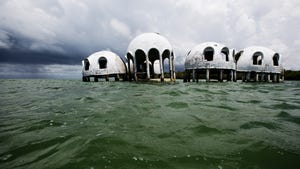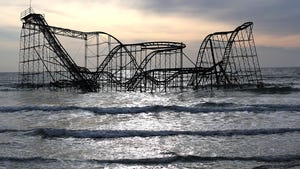Results 1 to 1 of 1
Thread Information
Users Browsing this Thread
There are currently 1 users browsing this thread. (0 members and 1 guests)
-
08-03-2014, 03:26 PM #1
Erosion a big threat to southwest Florida beaches
Erosion a big threat to southwest Florida beaches
The dome house of Cape Romano, Fla., exemplifies the power of erosion in southwest Florida. Stephen Doane, The (Fort Myers, Fla.) News-Press
Steve Doane, The (Fort Myers, Fla.) News-Press
2:59 p.m. EDT August 3, 2014

(Photo: Andrew West, The (Fort Myers, Fla.) News-Press)
CAPE ROMANO, Fla. — From the bow of Andrew Barksdale's 20-foot power cruiser you can see it: Six wrecked domes hovering on stilts above turquoise waters.
Behind it a dark storm cloud contrasts with the faded white exterior of the infamous landmark. The "dome house" of Cape Romano, Fla., used to require a walk to get to the Gulf, now it stands in 5 feet of water because of erosion.
"Even just a few years ago there was a nice sand beach right there, now it's all gone," Barksdale said on a recent visit to the site.
It's a reminder of how the ocean can reshape the coastline.
The southern end of Cape Romano is an area of southwest Florida that's exposed to the full force of the Gulf of Mexico. It's pounded by onshore waves and subject to strong tidal current and the evidence is glaring. Since the 1980s, when the dome house was built, the coastline has receded more than 200 feet.
Experts at the Rookery Bay National Estuarine Research Reserve say this type of erosion is normal for the barrier islands, but sea level rise could be a contributing factor.
Erosion is the process by which the ocean eats away at coastline through waves, tides and currents. It can be influenced by everything from wind to undersea objects.
In an area like Cape Romano wind, tides, and currents are known to move sediments along the shoreline, said Kevin Cunnif, research coordinator at Rookery Bay.
Cape Romano is the southern tip of Cape Romano Island, south of Marco Island in the Ten Thousand Islands.
Cape Romano is not monitored by Collier County, Fla., and isn't renourished like Vanderbilt, Park Shore and Naples beaches. This means the effects of erosion are much clearer than the populated coastline.
Sea level rise will exacerbate erosion because when the Gulf starts higher, it takes more sand with every wave, said Jim Beever, principal planner at the Southwest Florida Regional Planning Council.
"Every inch of sea level rise accelerates the rate sand is taken from the beach," he said.
Last year Collier and Lee counties spent roughly $15 million on beach renourishment projects. As storm events grow stronger and ocean levels creep up, it's plausible that cost could mount rapidly in the coming century.
The economic effects could be catastrophic as well.
Tourism pumps $2.6 billion into the local economy annually and employs an estimated one in five people in Lee County, Fla., according to county statistics.
If it's the lifeblood of the region and beaches are the heart. If the beaches decline, so does the economy.
A lot of what can be done to protect beaches is dictated by state and federal agencies, said Gary McAlpin, Collier's director of Coastal Zone Management.
Whenever the county needs to renourish its beaches, it must obtain permits from the Florida Department of Environmental Protection and the U.S. Army Corps of Engineers. Those permits spell out exactly what can and cannot be done to the beach from the volume of sand, to the timing of the project to the grit of the sand, McAlpin said.
"It doesn't leave much room for us to maneuver for sea level rise," he said.
http://www.usatoday.com/story/news/n...newstopstories
NO AMNESTY
Don't reward the criminal actions of millions of illegal aliens by giving them citizenship.
Sign in and post comments here.
Please support our fight against illegal immigration by joining ALIPAC's email alerts here https://eepurl.com/cktGTn
Similar Threads
-
Special GOP Election In Southwest Florida Turning Into Bloody Fued
By Newmexican in forum General DiscussionReplies: 1Last Post: 03-13-2014, 04:31 PM -
ON THE SOUTHWEST BORDER Understanding the Gang Threat
By JohnDoe2 in forum illegal immigration News Stories & ReportsReplies: 0Last Post: 09-21-2010, 02:19 PM -
Prosecutors criticized not pursuing Southwest Florida refuge
By AirborneSapper7 in forum illegal immigration News Stories & ReportsReplies: 1Last Post: 03-21-2009, 10:43 PM -
Sorry, Charlie, your mail shows Southwest Florida opposes Al
By AirborneSapper7 in forum Other Topics News and IssuesReplies: 0Last Post: 06-28-2008, 10:10 PM -
A Line in the Sand. Confronting the Threat at the Southwest
By CountFloyd in forum illegal immigration News Stories & ReportsReplies: 3Last Post: 11-30-2006, 10:51 PM


 LinkBack URL
LinkBack URL About LinkBacks
About LinkBacks






 Reply With Quote
Reply With Quote


Mike Johnson betrays border security for more foreign aid
04-18-2024, 10:31 PM in illegal immigration News Stories & Reports